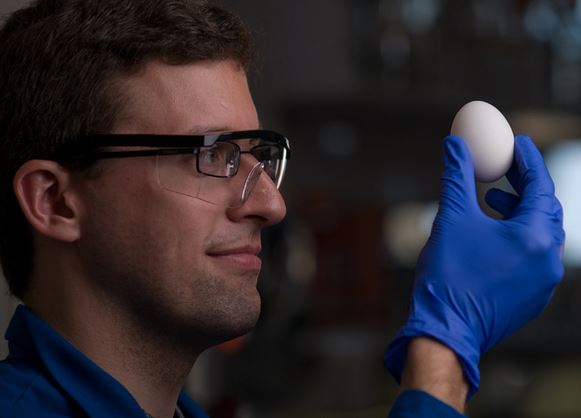American and Australian scientists have worked out how to unboil an egg, specifically the egg white. You pull apart tangled proteins and allow them to refold, they say.
The chemists from the University of California, Irvine (UCI), and Flinders University in South Australia say their innovation could significantly reduce costs for food production, cancer treatments and other segments of the $160 billion global biotechnology industry.
The study has been published in the journal ChemBioChem (citation below).

Scientists have developed a way of unboiling a hen egg. (Image: UCI)
UCI professor of chemistry and molecular biology & biochemistry, Gregory Weiss, said:
“Yes, we have invented a way to unboil a hen egg. In our paper, we describe a device for pulling apart tangled proteins and allowing them to refold. We start with egg whites boiled for 20 minutes at 90 degrees Celsius and return a key protein in the egg to working order.”
Like many scientists, Prof. Weiss has struggled to efficiently produce or recycle valuable molecular proteins that have a wide range of applications, but which usually “misfold” into structurally wrong shapes when they are formed, thus rendering them useless.
Prof. Weiss said:
“It’s not so much that we’re interested in processing the eggs; that’s just demonstrating how powerful this process is. The real problem is there are lots of cases of gummy proteins that you spend way too much time scraping off your test tubes, and you want some means of recovering that material.”
Speeding up the process from days to minutes
The problem with older methods is that they are costly and time-consuming. What the scientists describe as the equivalent of dialysis at the molecular level needs to be done for about four days. The new process only takes minutes, thus speeding things up by a factor of thousands, Prof. Weiss explained.
To re-create a protein (lysozyme) after an egg has been boiled, the scientists add a urea substance that “chews away” at the whites – turning the solid material into a liquid. But there are still protein bits balled up into unusable masses.
The researchers then employ a vortex fluid device, a high-powered machine designed by Professor Colin Raston’s laboratory at Flinders University. Shear stress within thin, microfluidic films is then applied to the tiny pieces, forcing them back into their original, untangled form.
The authors write in ChemBioChem “This method … could transform industrial and research production of proteins.”
Drug companies, for example, currently create cancer antibodies in costly hamster ovary cells that do not often misfold proteins. To be able to rapidly and cheaply re-form common proteins from E. coli bacteria or yeast could potentially accelerate protein manufacturing and significantly reduce the cost of cancer treatment.
Industrial cheese makers, farmers and industries that use recombinant proteins could also benefit.
UCI, which has filed a patent for the work, is working with interested commercial partners through its Office of Technology Alliances.
Citation: Yuan, T. Z., Ormonde, C. F. G., Kudlacek, S. T., Kunche, S., Smith, J. N., Brown, W. A., Pugliese, K. M., Olsen, T. J., Iftikhar, M., Raston, C. L. and Weiss, G. A. (2015), “Shear-Stress-Mediated Refolding of Proteins from Aggregates and Inclusion Bodies.” ChemBioChem. doi: 10.1002/cbic.201402427.
Video – How to unboil an egg

